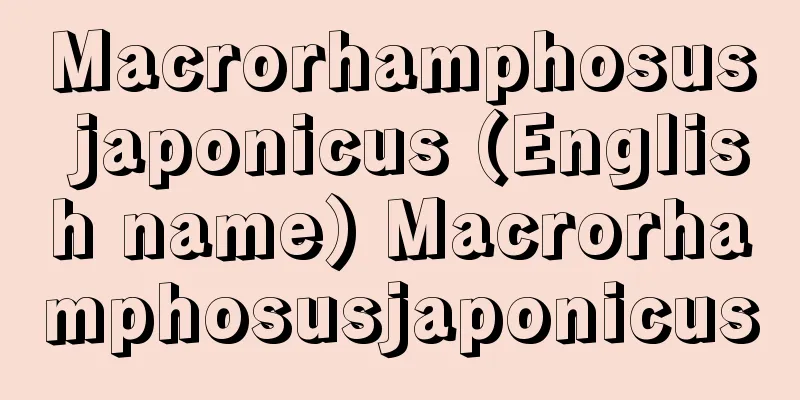Folk performing arts

|
It refers to the theater, dance, music, and rituals and events that incorporate these elements that have been cultivated and passed down by the residents themselves in the course of their local lives. As these are rooted in the region and rich in local color, they were previously called local performing arts or local arts, but a trend to change this to folk performing arts began to emerge around the time the Folk Performing Arts Society was formed in 1952 (Showa 27). This was because there was a concern that the name "local" would tend to lead people to think that the characteristics of these performing arts are limited to a small area, but in reality, this type of performing arts shows a faithful transmission of the fundamental folk culture that is universal to the ethnic group, even before it is regional. Therefore, by examining these performing arts broadly across the entire ethnic group, the foundations of the ethnic group's performing arts can be clarified, and by comparing them with performing arts that have been turned into art by members of a specific class, the process of the development and transformation of the ethnic group's performing arts can be clarified. The "National Folk Performing Arts Convention" started in 1950 and was sponsored by the Ministry of Education's Arts Festival Executive Committee, and was renamed the "National Folk Performing Arts Convention" in 1957, and gradually this name became more widely used and established (since 1968 it has been sponsored by the Japan Youth Center). Today, there are countless performing arts around the world that are called folk performing arts in Japan, but in other countries they are usually referred to as folk music or folk dance. [Haruo Misumi] Essence and characteristicsFolk performing arts originated as a collective expression of prayer by local residents for their daily lives, in line with their lifestyles. In Japan, agricultural lifestyles spread from the end of the Jomon period through the Yayoi period, and in the historical era, an agricultural society centered on rice cultivation was formed. In villages throughout the country, based on the belief that bountiful harvests guarantee a stable life and longevity, festivals were held to welcome gods at the turning points of the seasons based on the agricultural calendar, and rituals were held to pray for the completion of production and the rest of life, or to give thanks for the fulfillment of wishes. These ritual actions were the origin of performing arts, and uta (songs), mai (dances), and odori (festivals) were developed individually from these types of actions. Uta is a word that is related to hitting and pleading, and people chanted wish-filled incantations with the aim of impacting the other person's spirit with the power of the words that reside in the words and making their wishes come true. Mai means to turn or spin, and the act of spinning to achieve a state of ecstasy where humans and gods are one became stylized as dance, and the form of speaking the words of the gods in that state became the prototype of storytelling. Odori means to jump, and groups of people would jump and spin around, again to achieve the joy of being one with humans and gods, and also to use the power of that jump to expel evil spirits and suppress disasters. This led to elaborate costumes and the creation of various dances. These were performed repeatedly year after year at seasonal festivals, and the content of these dances matured as folk performing arts. First, at the beginning of the New Year, festivals are held to pray for a bountiful harvest for the coming year, but in rural areas, mainly on Little New Year, there are performances called Taasobi, Onda, Harutauchi, Okonai, and other performing arts that combine lines, impersonations, and songs, as well as dances such as the Rice Planting Dance and Enburi. Both of these mimic the process of rice cultivation, from leveling the rice field soil to plowing, sowing seeds, chasing birds, plowing the main field, rice planting, weeding, and harvesting, and sometimes even threshing, packing the rice into bales, and storing it in the storehouse. It was thought that if a group of people acted out the smooth rice cultivation and bountiful harvest in advance of the actual cultivation, the rice fields would respond to it and the rice would go through exactly as they had done. This is a type of so-called kankyo or kankyo magic, and based on this belief, people in fishing villages would send boats out to the shore and use songs and actions to announce a large catch. Then, in early spring, when the farming season begins, some areas perform songs and dances to pray for a fertile harvest, but there is also a custom of performing songs and dances in a flower-calming festival to stop the cherry blossoms from falling, as they are believed to be the dwelling place of the grain spirits. Next, the rainy season in summer is the season for rice planting, when the rice god is welcomed into the fields, and the village women put on elaborate makeup and sing songs in unison while planting the seedlings. Men play instruments such as bamboo sasara, drums, and flutes, while women sing love songs, to tempt the rice god. In the past, this was a spectacular performance scene in various places. The period from this time to early autumn is also an important time for rice growth, and for this reason people feared droughts, storms, cold damage, and insect damage that tend to occur during this season, as well as epidemics caused by bad weather. Due to this fear, people assumed that the cause of these disasters was the work of wild spirits or the spirits of people who died with grudges against this world, and so festivals were held to suppress and calm these wild spirits. First, they believed that getting rid of impurities would ward off disasters, so they would hold rituals to purify them by water, and they also honored vengeful spirits as goryo, and sometimes held goryoe ceremonies at Gion Shrine in Yasaka-go, Kyoto, with the help of the power of Gozu Tenno, a god who came from India. This was the famous Gion Goryoe, in which a line of floats and spears were paraded to Shinsen-en Garden, accompanied by noisy sounds of gongs, drums, and flutes, to send off the spirits. Later, this became even more spectacular, giving rise to the grand Gion Festival, and this form of festival became popular throughout the country. It was believed that dancing and leaping in large numbers while beating gongs and drums was effective in calming and sending off violent spirits, and so dances such as drum dances and gong dances were created all over the country. It was also believed that dancing this type of dance while chanting Buddhist prayers would be even more effective in pacifying vengeful spirits, and so the Nembutsu dance, accompanied by the accompaniment of gongs and drums, became very popular. Bon on the 15th of the seventh lunar month in early autumn, along with the 15th of the lunar New Year, is considered to be a festival day that divides the year in two. It is believed that ancestral spirits visit at this time, and that vengeful spirits that wander the land also come to receive festivals. It became common to perform Nembutsu dances to mourn these spirits and appease their souls, and this became the basis for the creation of Bon Odori dances in various regions. The period from this Bon festival to Hassaku is an important time for rice farmers just before the harvest, so Bon Odori and taiko drumming dances are sometimes performed to pray for a good harvest. Also, from this time to the fifteenth night of the eighth lunar month, it is the time of the field crop harvest festival in Honshu, and the rice harvest festival from southern Kyushu to the Ryukyu Islands, with grand singing and dancing to celebrate the harvest, and events such as tug-of-war. Around October lunar month, rice harvest festivals are held all over Honshu, and in each area, a feast of performing arts is held by the entire region. There are parades of floats and stalls, as well as Kagura, Bugaku, Kabuki, puppet theater, and the taiko drumming dance that was performed in the summer is sometimes re-performed as a dance of thanks for the fulfillment of wishes. Then, in the lunar November and December, Kagura suddenly becomes popular. Shimotsuki, the lunar November, is the season of the winter solstice, when the sun is at its lowest in the year. This is seen as a time when the life force of people and the universe is at its weakest, and so in order to revive that life force, a requiem ceremony is held to welcome the gods and ask for the impartation of the gods' souls. At this time, the Niiname Festival is also held, in which new grain is offered to the gods, and people also eat the rice eaten by the gods, which also results in the granting of the gods' souls. Kagura is performed as a ritual for this requiem and Niiname. In the past, shrine maidens who called upon the gods would become possessed by the gods themselves and perform songs and dances to impart the divine spirits that had possessed them to people, but this gradually changed to men dressed in masks and costumes as gods, dancing and stomping to show their divine power as a requiem gesture. Also, the Yudate Kagura dance, which involves boiling water in a kettle, offering it to the gods, and having people at the festival site showered with the water infused with the gods' breath in order to regenerate their souls, was popular throughout the country. In this way, people welcome the new year by regenerating their weakened souls into new, stronger ones, and based on the belief that the gods will visit at this time of year, bringing with them a new toshi (meaning a rice harvest), a custom spread throughout the country in which gods dressed in various costumes, such as Namahage, Kayutsuri, and Toshidon, would visit homes and offer blessings. Based on this custom, artisans performed blessing performances such as Manzai, Harukoma, Daikokumai, and Shishimai to offer prayers for the new year to each household. Thus, all over Japan, various kinds of performing arts are filled throughout the year, and the reason why these folk performing arts have taken root in the lives of the local residents and been handed down for so long is that there was a custom in various places to consider the performing arts performed at festivals as an important form of adult education for the villagers, assigning young people roles according to their age and training them in arts for many days to train their bodies and minds for adulthood. Also, for the Japanese people, who could not live a satisfying life without working hard all year round, festivals were the only opportunity where the whole community could devote themselves to singing and dancing, and it can be said that this is why performing arts full of vitality were born on the basis of festivals. In addition to village rituals, there was also a custom of relatives and believers gathering in homes and lecture groups to perform songs and dances in the form of small festivals, and these also became a place for the development and transmission of songs and dances in the society of the people. [Haruo Misumi] Types and classificationsThere are still a huge number of folk performing arts distributed throughout Japan today. For example, there are often five or six lion dances in a single town or village. The number is said to have decreased year by year since the Meiji era, but the current situation shows us once again how many performing arts the Japanese have nurtured in their hometowns. The variety of performing arts is therefore extremely diverse, but it was Honda Yasuji (1906-2001) who surveyed the entire country and classified them by type of performing art, religious beliefs, and artistic lineage. According to his Illustrated Catalog of Japanese Folk Performing Arts (1960), folk performing arts are broadly divided into five types: (1) Kagura (Sacred Music and Dance), (2) Dengaku (Dengaku), (3) Furyu (Furyu), (4) Shukufukue (Celebration Art), and (5) Foreign Lineage, and he further classifies these five as follows: (1) Those belonging to the category of Kagura include (1) Miko Kagura, (2) Izumo Kagura, (3) Ise Kagura, and (4) Shishi Kagura. (2) Those belonging to the category of Dengaku include (1) Yoiwai no Ta-asobi, (2) On-taishu Shinto Ritual. (3) Those belonging to the category of Elegant Style include (1) Nembutsu Dance, (2) Bon Odori, (3) Taiko Dance, (4) Kakko Shishimai, (5) Ko-uta Dance, (6) Aya Dance, (7) Tsukurimono Elegant Style, and (8) Kakari Dance. As part of the blessing arts of the Sofu-ryu and Neri-ryu (4), there are (1) Raihoshin (visiting gods), (2) Senzu Manzai (celebration of a thousand autumns), and (3) Naritamono (5) as part of the foreign tradition, there are (1) Gigaku (musical music), (2) Shishimai (lion dance), (3) Bugaku (dance music), (4) Ennen (longevity), (5) Bosatsuraigoue (the celebration of the 25 Bodhisattvas), (6) Onimai (demon dance) and Butsumai (hotoke dance), (7) Sangaku (rakugo), (8) Noh and Kyogen (noh plays), (9) puppet theater, and (10) Kabuki. This classification method was unique to Honda Yasuji, who had explored the entire country for many years, and it captures the characteristics and history of each type of folk performing art. In particular, he pointed out that Japanese folk performing arts originally had three main purposes: (a) praying for long life, (b) praying for good grain harvests, and (c) chasing evil spirits that threatened people's lives. His insight in making Kagura, which is based on (a), Dengaku, which is based on (b), and Furyu, which is based on (c), the pillars of his classification of folk performing arts was brilliant, and has remained the basis for subsequent classification proposals. Moreover, Ikeda Yasaburo (1914-1982), who followed the academic tradition of Orikuchi Shinobu, proposed in works such as "Japanese Performing Arts" (1957) that the folk restrictions that make performing arts possible are (1) season, (2) stage, (3) actors, (4) audience, and (5) script, and attempted classification based on each of these elements. For example, if we attempt a classification based on the season (1), we would get the following: (1) New Year's performing arts, (2) Spring performing arts, (3) Summer performing arts, (4) Bon Festival performing arts, (5) Autumn performing arts, and (6) Winter performing arts. This seasonal classification overlaps in many ways with Honda's classification of forms, and we can understand how folk performing arts have taken their form in relation to seasonal festivals. Here, we present a classification by form that focuses on the folk characteristics of folk performing arts, while also taking into account the historical development of each individual performing art. [Haruo Misumi] Kagura performanceAt the festival grounds, a shaman (shaman) becomes the kami-throne (kami-sama) and dances with sakaki (branch of a tree) or sasa (bamboo grass) in his hands, becoming possessed by a god and giving oracles. The origin of this art was the art of distributing the divine spirits that dwell in the kami- throne to people, and later, after the dance of inviting the gods, a costumed god appears and performs a song and dance of requiem. Kagura is thought to be a phonetic contraction of kamkura, which means the kami-throne. Historically, it was performed as a requiem incantation to welcome the gods and regenerate their souls around the time of the waning sun in November, and one example of this was the requiem rituals held at the ancient imperial court. Later, the Imperial Court gave birth to Naishidokoro no Mikagura and other forms of Kagura, and among the general public, various forms of Kagura were created all over the country, incorporating influences from Onmyo-do, Shugendo, Ise Shinto and other religions; however, many of these older forms are performed in the winter. [1] Torimono Kagura This form originated from a dance performed to invite the gods while waving harvested items such as sakaki. Currently, the miko dance performed by shrine maidens holding sakaki branches, bamboo grass, bells, and hiougi fans has spread to various regions. There are also old kagura dances scattered throughout the Chugoku and Shikoku regions in which male priests dance holding offerings and perform oracles. However, a form in which the first half of the dance is a torimono dance to invite the gods or purify them, and the second half features a masked and costumed god appearing to perform a dance drama based on the myths of the Kojiki and Nihon Shoki, also originated at the Sada Shrine in Izumo in the early modern period and has since spread throughout the country. This is the case for the Daidai Kagura of the Kanto region, which was further refined to give birth to the Sato Kagura of Edo. The kagura and kami dances of the Miyazaki and Kagoshima regions of Kyushu also convey the old style. [2] Yudate Kagura This is a form of harvesting kagura centered on the Yudate festival. Water is boiled in a kettle placed in front of the altar, and dancers holding the harvest offerings offer the water to the god, and also share the water, which has been infused with the god's breath, with the people. A masked god appears and showers the crowd with water and performs a dance of repose. The Yudate ritual at Ise Geku is the basis of early modern Yudate Kagura. Particularly famous are Shimotsuki Kagura in the Toyama region of southern Shinshu, the winter festival and purification festival in Tenryu village, and the flower festival in Oku-Mikawa, and there is also Shimotsuki Kagura at Horowasan in Ugo in the Tohoku region. [3] Shishi Kagura: A form of Kagura dance in which a lion's head is treated as a sacred object. In the Tohoku region, Yamabushi Kagura, Bangaku, and Noh dances, which were once performed by mountain priests, this is called Gongenmai, and dances are performed at each household on New Year's Day and other family celebrations to pray for prosperity in the household, bountiful harvests, and the elimination of disasters. Dramatic dances such as Kamimai, Aramai, Bushimai, and Onnamai are also performed. Meanwhile, in the Ise and Owari regions, during the Edo period, groups of Oshi (masters) appeared who traveled around the country carrying lion heads bearing the divine power of Ise Grand Shrine and Atsuta Grand Shrine, and they performed lion dances in towns and villages all over the country, with acrobatics and skits performed as entertainment, and even a type of lion play was born in which a female lion head performer would act out a scene from a play. The art of Oshi still remains in Kuwana, Ise, under the name of Daikagura, but Daikagura was introduced in Edo and became a vaudeville show, and today it features acrobatics. It has also spread to various places as a festival art form performed by rural residents. [Haruo Misumi] DengakuThis is a performing art that has been performed in connection with rice-cultivation rituals, and there are versions that are performed at New Year's festivals to celebrate a good harvest, and others that are mainly performed at rice planting time. [1] Rice Field Play and Rice Planting Dance At the beginning of the year, the smooth progress of rice cultivation and the appearance of a bountiful harvest are imitated through gestures and dance. Dances with a strong element of imitation are called Rice Field Play, Harutauchi, Onda, etc., while those centered on dance are called Rice Planting Dance, Enburi, etc. The former are distributed throughout the country, while the latter are concentrated mainly in the Tohoku region. In the former, some places combine with temple Shushoe to perform Dengaku and Oni no Mai in addition to Rice Field Play. [2] Rice planting entertainment There are various customs in which a god is welcomed to rice planting, and a gorgeously dressed young maiden plants the seedlings and performs songs and dances. Hayashida and Hanataue, which are traditional in farming villages near the Chugoku Mountains, feature a sambai, who plays the role of the god of the rice fields, singing to each other while men play drums, flutes, and bamboo stalks in the background. This scene is also depicted in the Eiga Monogatari, written in the mid-Heian period. Dengaku, which became popular in the capital from the end of the Heian period, is thought to have been based on this rice planting music. Hōtai entertainers belonging to temples and shrines called themselves dengaku hoshi, and created an artistic form of dengaku by adding acrobatics and Noh to the music dance. After the Nanboku-chō period, dengaku was overtaken by Sarugaku and dispersed to the provinces, and today it is often performed together with Ta-yu in connection with the Shussetsu-e festival held at the beginning of the New Year. [Haruo Misumi] Elegant artFuryu was originally pronounced as miyabi and meant refined, urban beauty, but in the mid-Heian period, it came to mean the beauty of mansions, gardens, costumes, and tools that embodied that elegance , and was called furyu. At the Gion Goryoe festival held at that time, gorgeously designed floats and hoko floats were displayed, and parades in lavish costumes played music and danced, so furyu also came to be the name for festivals and performing arts, and this led to the development of various types of performing arts. [1] Nembutsu Art Nembutsu dance is a dance performed while chanting the name of Amida Buddha. It was danced for the purpose of liberation from one's worldly desires and sending off the souls of the deceased. Bon Odori dances were born all over the country from this Nembutsu dance. Other examples of this type include the Bodhisattva Raigoe and Dai Nembutsu Kyogen, which were performed to spread the Nembutsu faith. [2] Taiko Drum Dance: A large group of people dance while beating drums to ward off disasters or pray for rain. [3] Shishi-odori (Furyu Shishimai) Although the name is Shishi, dancers with deer or dragon heads dance while beating drums and kakko. This type of dance is found mainly in eastern Japan. [4] Kouta Dance Kouta is the name of an old popular song, and is a group dance performed rhythmically in gorgeous costumes. Some dances, such as the Ayako Dance of Echigo and the Kashima Dance of Okutama, are reminiscent of early Kabuki dance. [5] Harvesting Dance: This dance involves holding up and dancing to various harvested items, such as sticks, swords, naginata, spears, bamboo, umbrellas, hats, oars, and artificial flowers. [6] Parades These include floats, hoko floats, floats, food stalls, and costume processions, and are often seen in urban festivals. [Haruo Misumi] Local performing artsOnce transformed into a performing art in the capital, Osaka, or Edo, the mainstream of the art flourished in the center, but many of these art forms spread to the provinces and became indigenous to each region as local arts, and are performed at festivals around the country. [1] Local Bugaku In ancient times, Bugaku was introduced from the continent to the great temples of the Kinai region and the Imperial Court, and spread to local shrines and temples, where it has been preserved in its own unique form. The most notable example is the Shitennoji Temple in Osaka. [2] Regional Noh Since the Nanboku-cho period, Sarugaku Noh, which was perfected by Zeami and others, spread to various places and gave rise to Noh with a strong regional flavor, such as the Noh and Kyogen of Nohgo in Mino and Kurokawa Noh in Dewa. [3] Regional Kyogen Kyogen, which, in keeping with the style of Sarugaku Noh, was developed into an art form in the capital, also spread to the provinces. The Sagi school of Kyogen, which had disappeared in the capital, also took root in Sado and Yamaguchi. [4] Regional Kabuki Kabuki, which was created in the early modern period as the flower of Edo and Kamigata, was popular in the provinces, and traveling actors settled in the provinces, giving rise to local forms of kabuki performed by local residents. Even today, local plays with unique regional flavors, such as Hinoemata Kabuki in Aizu, Oshika Kabuki in Shinshu, and Banshu Kabuki in Harima, are handed down in various regions. [5] Regional Bunraku: In the early modern period, a three-person puppet theater based on the Gidayu style of puppetry became popular on the stage of Osaka. Since Awaji Bunrakuken became involved in the performances, it has come to be called Bunraku and has been handed down to the present day. It has since spread widely to other regions and is found in various places from the Kanto region to Kyushu. [Haruo Misumi] ArgumentativeIt is a performing art that features speeches, stories, and speeches, and is mainly accompanied by instrumental music and dance. [1] Kadotonai arts: Kadozuke arts in which performers visit houses and offer congratulatory speeches at their gates. These include Banzai, Harukoma, Daikokumai, and Saimon. [2] Street performance: performing arts that are performed on the streets or in squares, such as the Ameya Dance and Monkey Showdown. [3] Narration dance: A dance centered around storytelling, such as Kowaka dance. [Haruo Misumi] PuppetryA wide variety of puppet performing arts, excluding local Bunraku, are handed down in different regions, including the Oshirasama of the Tohoku region, who tells a story while holding a piece of mulberry wood, the Seino puppet of Kitakyushu, who manipulates a wooden puppet that is a sacred object, string puppets, one-man puppet shows, mechanical puppets used at festival floats, and tsunabi puppets with firework mechanisms. [Haruo Misumi] compositeThere are also performing arts in various regions that combine several genres, such as Kagura and Dengaku, or Dengaku and Bugaku. One such example is the performing art called Ennen, which is handed down at temples such as Motsu-ji Temple in Hiraizumi, Rikuchu. The Snow Festival of Niino in southern Shinshu and the Dengaku of Nishiura in Ouenshu were also competitions of various performing arts, including Kagura, Dengaku, Dengaku, and Noh, that were performed at the old Shussetsu-e style New Year's festival called Okonai. [Haruo Misumi] Research progress and trendsResearch into folk performing arts became more active after the Folk Arts Society was founded in 1927 (Showa 2), and its journal Folk Arts was launched the following year. Traditional performing arts in various regions, which had previously tended to be viewed as strange customs of outlying regions, came to be seen as important ethnic cultural heritage and as living historical materials that told the history of ethnic groups. Researchers such as Yanagita Kunio, Orikuchi Shinobu, Kodera Yukichi, Nagata Kokichi, and Hayakawa Kotaro came together to conduct research in various regions, and research developed rapidly with the emergence of researchers such as Nishitsuno Masayoshi, Honda Yasuji, Miyao Shigeo, and Kitano Hiromi. The performers themselves also became more aware of their role in passing on performing arts. After the Second World War, there were concerns about the decline of performing arts, but the intensification of research activities has supported the immediate passing on of performing arts, and the preservation of folk performing arts has been advocated in the national policy for protecting cultural properties implemented since 1954 (Showa 29). Currently, measures are being taken to designate performing arts that have historical significance and are characteristic of a particular school or region as Important Intangible Folk Cultural Properties of the country and to implement preservation measures. Research activities are also expected to develop further in the future, with the establishment of the Folk Performing Arts Society in 1984, which brings together researchers from all over the country. Each prefecture also has its own system for designating intangible folk cultural properties, and each local government is also making an effort to preserve and pass on these. Many elements of the folk performing arts that have been passed down in Okinawa Prefecture are different from those on the mainland, and they convey the rich performing arts of the south to the present day. [Haruo Misumi] "Local Performing Arts" by Gunji Masakatsu (1958, Sogensha)" ▽ "Illustrated Catalog of Japanese Folk Performing Arts" by Honda Yasuji (1960, Asahi Shimbun)" ▽ "Japanese Folk Performing Arts" by Honda Yasuji, 5 volumes (1966-1973, Mokujisha)" ▽ "An Introduction to Japanese Folk Performing Arts" by Misumi Haruo (1972, Tokyodo Publishing)" ▽ "Introduction to Folk Performing Arts" by Nishikado Masahiro (1979, Bunken Publishing)" ▽ "Dictionary of Japanese Folk Performing Arts, compiled by the National Trust of Japan (1976, Daiichi Hoki Publishing)" ▽ "Dictionary of Folk Performing Arts" by Nakai Kojiro, Nishikado Masahiro, and Misumi Haruo (1981, Tokyodo Publishing)" [Reference items] | | | | | | | | dance| | | | | | | |Bon | | |This is a folk performing art handed down in the Shimotsuke and Takaharada districts of Onnadani, Kashiwazaki City. It consists of a small song dance performed by young women, a hayashi dance performed by men, and kyogen. There are 11 types of small song dance, including the Kogiriko Dance, Hitachi Dance, and Obaragi Dance, and they are important in understanding early Kabuki dance. They are open to the public on the second Sunday of September every year. The photo shows the Obaragi Dance. Nationally designated Important Intangible Folk Cultural Property Kashiwazaki City, Niigata Prefecture © Niigata Prefecture Tourism Association "> Ayako Dance Ningyo Joruri is a puppet theater handed down in the Fukase and Higashi-Futakuchi districts of Oguchi, formerly Hakusan City. "Deku" means doll, and it is also called Fumiya dolls or Fumiya kuzushi. Its origins are unclear, but it is said to retain the form of puppet theater in its early stages of development, making it valuable in the history of performing arts. The photo shows Dekumawashi in the Fukase district. Nationally designated Important Intangible Folk Cultural Property Hakusan City, Ishikawa Prefecture © Hotto Ishikawa Tabi Net "> Tail twist This is a Bon Kyogen performance handed down at Kosaiji Temple. It is also called Oni-mai. The performers, stage equipment, costumes, and everything else are all prepared by parishioners and local residents, and it takes place every year on August 16th. The photo shows the "big introduction" of the four-part tale of hell, in which a red demon scolds the dead who have been punished for their crimes. Nationally designated Important Intangible Folk Cultural Property Yokoshibahikari Town, Sanbu District, Chiba Prefecture © Chiba Prefecture Tourism and Products Association Demons coming A Shinto Noh performance dedicated to Kasuga Shrine in the Kurokawa area of Tsuruoka City (formerly Kurokawa, Kushibiki Town). This form of Noh has been passed down by farmers since the Middle Ages, and is a rare example of faith, art, and life beautifully integrated. The photo shows "Suien no Noh." Nationally designated Important Intangible Folk Cultural Property Tsuruoka City, Yamagata Prefecture ©Yamagata Prefecture "> Kurokawa Noh Nationally designated important intangible folk cultural property Shimokoshikijima, Satsumasendai City, Kagoshima Prefecture © Kagoshima Prefecture Tourism Federation Toshidon of Koshikijima It is performed at Dainichido Hall in Hachimantai on the second day of the New Year. The photo shows the "Torimai" dance of Ozato village. Three children wear Tori Kabuto helmets and dance to the accompaniment of music. Nationally designated Important Intangible Folk Cultural Property Kazuno City, Akita Prefecture © Akita Prefecture Tourism Division "> Dainichido Bugaku Nationally designated important intangible folk cultural property Tsukubamirai City, Ibaraki Prefecture ©Ibaraki Prefecture "> Tug-of-wielding fire (Obari Matsushita style) Nationally designated important intangible folk cultural property Tsukubamirai City, Ibaraki Prefecture © Tsukubamirai City "> Tug of fire (Takaoka style) Yutate Kagura is a traditional dance handed down in the Toyama region in southern Nagano Prefecture. It is also called the Shimotsuki Festival or Oshi Festival. It is held in each village in turn every year from early December. Water is boiled in a yukamata (pot of boiling water) and offered to the gods, and the attendees are also purified by pouring the water over them. The photo shows the Yutate at Toyama Tenmangu Shrine in the Minami Shinano region. Nationally designated Important Intangible Folk Cultural Property Iida City, Nagano Prefecture © Shinshu-Nagano Tourism Association "> Toyama Festival (Toyama's Shimotsuki Festival) Bon Odori dance handed down in Nishimonai, Ugo-machi. Ganke Odori (Jinku) is danced mainly by women wearing a bird-chasing hat or a Hikosa hood (also written as Hikosa hood or Hikosan hood) and a hamoni. Nationally designated important intangible folk cultural property Ugo-machi, Ogachi-gun, Akita Prefecture © Akita Prefecture Tourism Division "> Nishimonai Bon Dance A type of rice planting dance that prays for a good harvest that year. The photo shows "Oniiwa Enburi," which was once performed by large landowners and powerful merchants. A tayu wearing a horse-head hat performs a dance that expresses the movements of sowing seeds and planting rice. Nationally designated Important Intangible Folk Cultural Property Hachinohe City, Aomori Prefecture ©Aomori Prefecture "> Hachinohe Enburi Take Kagura is a dance handed down in the Take area of Oosakocho, Hanamaki City. It is a wild and heroic dance, and is performed at the annual festival of Hayachine Shrine. Hayachine Kagura was registered as an intangible cultural heritage by UNESCO in 2009. Nationally designated important intangible folk cultural property Hanamaki City, Iwate Prefecture © Hanamaki Tourism Association Hayachine Kagura The setting is a nationally designated important tangible folk cultural property. Hiezaki Village, Minamiaizu County, Fukushima Prefecture © Fukushima Prefecture Tourism and Products Association Hinoeda Kabuki Nationally designated important intangible folk cultural property Horohayama Haushiwake Shrine, Yokote City, Akita Prefecture © Akita Prefecture Tourism Division Shimotsuki Kagura at Mount Horoha This is a Shinto ritual held every four years on February 14th at Kamo Shrine in Omori-machi, Fukui City. It is a type of rice-playing ceremony, a form of art to celebrate a good harvest. The photo shows four children wearing flower hats performing the Dengaku dance. The dance is dedicated on a stage made of a board placed on four rice bales. Nationally designated Important Intangible Folk Cultural Property Fukui City, Fukui Prefecture © Fukui Prefecture Tourism Federation "> Mutsuki Ceremony This dance is handed down from father to son in the Hayashi family, the priests of Yachi Hachiman Shrine. It consists of 10 pieces, including "Enpo," "Taiheiraku," and "Nasori." The photo shows "Ryo-o." Nationally designated important intangible folk cultural property, Kahoku Town, Nishimurayama County, Yamagata Prefecture ©Yamagata Prefecture "> Yachi Bugaku (Hayashiya Bugaku) A festival to celebrate a good harvest held at Izu Shrine in Niino, Anan Town, on January 14th and 15th. Dengaku and Bugaku dances, the lighting of large torches, and festivals in the large gardens are held throughout the night. The photo shows the first dance in the garden, "Saihou," which represents Toshigami (the god of the year). Nationally designated Important Intangible Folk Cultural Property Anan Town, Shimoina District, Nagano Prefecture © Shinshu-Nagano Prefecture Tourism Association "> Snow Festival (Niiyano Snow Festival) Source: Shogakukan Encyclopedia Nipponica About Encyclopedia Nipponica Information | Legend |
|
各民族それぞれの地域生活のなかで、住民自らが育て、伝承してきた演劇、舞踊、音楽、およびそれらの要素を備えた儀礼や行事等をいう。地域に根ざし、郷土色に富むところから、以前は郷土芸能、郷土芸術などとよばれたが、これを民俗芸能と言い改める風潮が、1952年(昭和27)の「民俗芸能の会」の結成時あたりから生まれるようになった。郷土の名がとかくその芸能の特性を一小地域内のものと認識させる懸念があるためであり、しかし実際には、この種の芸能には、地域性以前に、民族が普遍してもつ基層的な民俗文化の忠実な伝承がみられるため、これらの芸能を広く民族全体にわたって考察することで民族の芸能の基層を明らかにし、さらに特定階層者によって芸術化せられた芸能と比較することで民族の芸能の発展・変容の経過を明らかにすることができる、との認識からである。1950年に始まった文部省芸術祭執行委員会主催の「全国郷土芸能大会」も、1957年以来「全国民俗芸能大会」と改称するようになり、漸次この呼称が一般化し、定着した(1968年以降は日本青年館主催)。今日、日本で民俗芸能と呼称される類の芸能は、もちろん世界各地にも無数にあるが、外国のものは通常、民族音楽や民族舞踊の名でよばれることが多い。 [三隅治雄] 本質と特色民俗芸能は、地域住民の生活に即し、その生活に対する住民の祈りの集団的表現として示されたのがその原点であった。すなわち、わが国では、縄文時代晩期から弥生(やよい)時代にかけて農耕生活が普及し、歴史時代に入って稲作を中心とした農耕社会が形成されたが、各地村落では農作物の豊穣(ほうじょう)が即生活の安泰、生命の長久を約束するとの考えから、農耕暦を軸に季節の折り目折り目に神を迎えて祭りを営み、生産の完遂と生命の安息を祈り、あるいは願成就(じょうじゅ)の感謝を捧(ささ)げる儀礼を行った。その儀礼行動が芸能の母胎で、ウタ(歌)、マイ(舞)、オドリ(踊)などはこの種行動の個々に発展したものであった。ウタは、打つ、訴えるなどと通じる語で、言語のなかに宿る言霊(ことだま)の力で相手の霊魂に衝撃を与え、おのが願望を成就させる目的から、願意を盛った呪詞(じゅし)を高唱した。また、マイは回る、旋回するの意で、神人一体の恍惚(こうこつ)状態を得るために旋回した行為が様式化して舞になり、その状態のなかで神の詞(ことば)を述べる形が語物(かたりもの)の祖型となった。オドリは跳躍の意で、集団で跳躍旋回して、これまた神人一如の歓喜を得、またその威力で悪霊追放、災厄鎮圧の目的を果たそうとし、それが華麗な装いを凝らすようになって、さまざまの踊りを生んだ。これらが季節ごとの祭りに年々繰り返し行われて民俗芸能としての内容を熟成させるようになったのである。 まず新春、年の初めには当年の作物の豊穣を祈願予祝する祭事を催すが、農村では小(こ)正月を中心に、田遊(たあそび)、御田(おんだ)、春田打(はるたうち)、オコナイなどと称する、台詞(せりふ)、物真似(まね)、歌謡などを交えた芸能や、田植踊、えんぶりなどの踊りを演じる。ともに、田の土ならしから代掻(しろか)き、種播(たねま)き、鳥追い、本田の代掻き、田植、田の草取り、刈り入れまでの稲つくりの過程を模擬し、ときに脱穀から俵詰め、倉入れなどのさままで演じるという内容のもので、このように実際の耕作に先だって、あらかじめ稲作が順調に行われて豊作に恵まれるさまを集団で演じておけば、田がそれに感応して、行ったとおりのことが実現できると考えたのである。いわゆる感応呪術、類感呪術の一種で、この信仰に基づいて、漁村などでは浜に船を出して大漁のさまを歌や所作で示すようなことも行った。 ついで陽春、耕作の開始期になると豊穣祈願の歌舞を演じる土地もあるが、そのころ咲く桜を穀霊の宿りとみ、その落花を押しとどめる鎮花祭の歌舞を演じる風もあった。 ついで夏の梅雨(つゆ)どきは田植の季節で、田の神を田に迎え、村の女たちが化粧を凝らして歌を斉唱しながら苗を植える。男たちが簓(ささら)、太鼓、笛などを奏し、女たちが恋歌をうたうのも田の神の心をそそるためで、昔は各地に華麗な芸能風景を展開したものであった。また、この時期から秋口にかけては稲の成長のだいじなときで、それだけにこの季節におこりやすい干魃(かんばつ)や暴風雨、冷害、虫害などが人々には恐怖の的であり、また天候不順から発生する疫病も悩みの種で、その恐懼(きょうく)の心情から、それらの災厄の原因を、荒魂(あらみたま)の神やこの世に恨みを残して死んだ人の亡魂のしわざと想定して、それらの荒々しい霊魂を押さえ鎮める祭りを催した。第一には穢(けが)れを払うことが災厄を寄り付かせぬ因になるとして、水辺で祓(はらえ)の祭儀を行うこともあり、また怨霊(おんりょう)を御霊(ごりょう)と尊称し、天竺(てんじく)渡来の牛頭天王(ごずてんのう)の力をも借りて京都八坂郷の祇園(ぎおん)社で御霊会(ごりょうえ)を営むことなどもあった。有名な祇園御霊会がこれで、御霊を鎮送するのに、山・鉾(ほこ)を連ね、鉦(かね)、太鼓、笛をかしましく奏して神泉苑(えん)まで練って行ったのが、のち一段と華やかになって祇園祭の盛儀を生み、この祭礼の形が諸国に流行した。鉦・太鼓を打ちつつ大ぜいで踊り跳ねることが荒々しい魂を鎮め送るのに効があるとの理解から、太鼓踊、鉦踊などの類を各地に輩出させ、念仏を唱えてこの種の踊りを踊れば、なおのこと怨霊鎮送に効があるとして、鉦・太鼓ではやし立てる念仏踊が盛んに行われた。 秋口の旧7月15日の盆は、旧正月15日とともに、1年を二つに分ける節日と考えられ、この時期、祖霊が訪れるとの信仰があり、さらに地境にさまよう無縁の怨霊なども祭りを受けにくるとして、これらを弔い、魂を鎮めるのに念仏踊をもってすることが普及し、これを基に盆踊りが各地に生まれた。 この盆から八朔(はっさく)ごろは、稲作にとっては収穫直前のだいじな時期で、そのため豊作祈願の思いを盆踊りや太鼓踊などに込めて演じることがあり、また、このころから旧8月十五夜ごろは、本州ならば畑作の収穫祭、九州南部から琉球(りゅうきゅう)列島にかけては稲の収穫祭の時期で、その収穫を祝う歌舞が盛大に催され、綱引きなどの行事も行われる。旧10月前後は本州各地の稲の収穫祭で、各地とも地域をあげての芸能の饗宴(きょうえん)が繰り広げられる。山車(だし)、屋台の練り行列もあれば、神楽(かぐら)、舞楽(ぶがく)、歌舞伎(かぶき)、人形芝居等々から、夏季演じた太鼓踊などを願成就のお礼の踊りとして再演することがある。 ついで旧11月、12月になると俄然(がぜん)神楽が盛んになる。旧11月の霜月は一年中でもっとも太陽の衰える冬至の季節で、それを人や宇宙の生命力の衰弱のときとみて、その生命力の復活を図るために神を迎え、神の霊魂の分与を求める鎮魂祭を行った。そしてまたこのとき、新穀を神に献ずる新嘗祭(にいなめのまつり)を催し、神の召し上がる米を人もまた頂いて、そのことでも神の御魂の付与を得た。この鎮魂や新嘗の儀礼として演じられたのが神楽である。古くは、神招(お)ぎをした巫女(みこ)が自身神がかりして、わが身に憑(つ)いた神霊を人々に分与する歌舞を演じたものが、しだいに、仮面・仮装の神に扮(ふん)した男が神威を示す舞や足踏みを行って鎮魂の所作とするというふうに変わった。また、釜(かま)に湯を沸かし、その湯を神に献じ、神の息吹のかかった湯を祭場の人々に浴びせることで魂の再生を図るという、湯立(ゆだて)の行事を歌舞で演じる湯立神楽も各地で盛んに行われた。こうして衰えた魂を新しく強力なものに再生させて、人々は新しい年を迎えるわけであるが、その年の改まりの季節には、新しいトシ(稲の実りの意)を携えた神々が来訪するとの信仰から、なまはげ、カユツリ、トシドンなど、仮面・覆面などさまざまの仮装の神々が家々を訪問して祝言を述べたりする習俗が各地に普及し、その習俗を基盤に、万歳(まんざい)、春駒(はるこま)、大黒舞(だいこくまい)、獅子舞(ししまい)など、新春のことほぎを各戸に捧(ささ)げる祝福芸が職業者によって行われた。 こうして、日本各地は、1年を通じて各種の芸能で埋め尽くされるわけだが、これら民俗芸能が各地住民の生活のなかに根を下ろして久しい伝承をみるようになった理由には、祭りに行う芸能を村落のだいじな成人教育と考えて、青少年に年齢に応じた役を与え、何日もにわたる技芸の稽古(けいこ)を通じて、成人たるにふさわしい身心の鍛練を行う風習が各地にあったことなどもあげられる。また、年中汗水流して働かねば満足のいく生活が与えられない日本の民衆にとって、祭りが唯一地域をあげて歌舞に明け暮れることの許される機会で、それゆえに生命力に富んだ芸能が祭りを基盤に生まれたともいえるのである。なお、村落の祭祀(さいし)のほかに家や講単位に縁者、信者が集まって小さな祭事の形をとりながら歌舞を演じる風があり、これも民衆社会における歌や踊りの育成・伝承の場となった。 [三隅治雄] 種類と分類日本全国に分布する民俗芸能は今日もおびただしい数に上る。獅子舞一つをとらえても、1町村に五つ、六つという土地もざらにある。明治年間以来、年々減少しているといわれるのに、なおこの状況だから、いかに日本人が数多くの芸能を郷土にはぐくんだかが改めて痛感される。したがってその種類も多彩を極めるが、これを全国的に通観して、芸能の形態や信仰内容、あるいは芸脈から種類の分類を行ったのは、本田安次(やすじ)(1906―2001)である。彼の『図録日本の民俗芸能』(1960)によれば、まず、民俗芸能を、大きく(1)神楽(かぐら)、(2)田楽(でんがく)、(3)風流(ふりゅう)、(4)祝福芸、(5)外来脈、の5種に分け、さらにこの五つを次のように分類している。 (1)の神楽に属するものとして、〔1〕巫女(みこ)神楽、〔2〕出雲(いずも)流神楽、〔3〕伊勢(いせ)流神楽、〔4〕獅子神楽 また、折口信夫(おりくちしのぶ)の学統を継ぐ池田弥三郎(やさぶろう)(1914―1982)は、『日本人の芸能』(1957)などにおいて、芸能を成立させる民俗的制約に、(1)季節、(2)舞台、(3)俳優、(4)観客、(5)台本、があるとして、それぞれの項を軸にしての分類を試みることを提唱している。たとえば(1)の季節を軸に一つの分類を試みれば、〔1〕新春の芸能、〔2〕春の芸能、〔3〕夏の芸能、〔4〕盆の芸能、〔5〕秋の芸能、〔6〕冬の芸能、といった形である。この季節的分類は、おおよそ本田案の形態分類と重なり合うところが多く、民俗芸能がいかに季節の祭事とかかわって芸能としての形を整えてきたかが了解できる。ここでは、民俗芸能の民俗的性格に着目しつつ、なお芸能個々の歴史的展開をも顧慮しての、形態別分類を示しておく。 [三隅治雄] 神楽芸祭場において、巫者(ふしゃ)が神座(かむくら)となり、榊(さかき)や笹(ささ)などを手にして舞い、自身神がかりして託宣を行い、かつは神座に憑(つ)く神霊を人々に分与する魂(たま)ふりのわざが起源で、のち、神招ぎの舞のあと仮装の神が出現して鎮魂の歌舞を演じる風を生んだ。カグラは神座を意味するカムクラの音略とみられる。歴史的には、太陽の衰える霜月ごろ、神を迎えて魂の再生を図る鎮魂呪術として演じたのが古く、古代宮廷における鎮魂祭の儀礼などがその一つであった。のち、宮廷では内侍所御神楽(ないしどころのみかぐら)などを生み、また民間では陰陽道(おんみょうどう)、修験道(しゅげんどう)、伊勢神道(いせしんとう)などの影響を取り込みつつ各地にさまざまの神楽を生んだが、その古風なものの多くは冬季に行われる。 〔1〕採物(とりもの)神楽 榊などの採物を振りつつ舞った神招ぎの舞を祖型とするもの。現行では、榊、笹、鈴、檜扇(ひおうぎ)などを手にして舞う巫女(みこ)舞が各地に普及する。また、男性神職が幣(ぬさ)などを手にして舞い、託宣を行う古い神楽も中国・四国地方に散在するが、前半に神招ぎや清めの採物舞を演じ、後半に仮面・仮装の神が出現して記紀の神話に取材した舞劇を演じる形も、近世初頭に出雲(いずも)の佐太(さだ)神社を中心におこり、その後全国に普及した。関東の太太(だいだい)神楽などもそれで、それがさらに洗練化して江戸の里神楽などを生んだ。九州の宮崎・鹿児島地方の神楽や神舞(かんめ)も古風を伝える。 〔2〕湯立(ゆだて)神楽 湯立の祭事を中心とした採物神楽。神前に据えた釜に湯を沸き立たせ、採物を手にした舞人がその湯を神に献じ、また神の息吹のかかった湯を人々に分かつ。仮面の神が出て群衆に湯を浴びせたり、鎮魂の舞をまう。伊勢外宮(げくう)の湯立儀礼などが近世の湯立神楽の基盤となる。南信州の遠山(とおやま)地方の霜月神楽や天龍(てんりゅう)村の冬祭・お潔(きよ)め祭、奥三河の花祭などがとくに名高く、東北地方にも羽後の保呂羽山(ほろわさん)霜月神楽などがある。 〔3〕獅子神楽 獅子頭(がしら)を御神体として舞わす神楽。東北地方に分布する、かつて山伏が演じた山伏神楽、番楽(ばんがく)、能舞(のうまい)などでは、これを権現舞(ごんげんまい)と称し、正月とか家の祝事などに各戸を巡って、家内繁盛、五穀豊穣、災厄鎮送を祈祷(きとう)する舞を演じる。そしてそれに付属して、神舞、荒舞、武士舞、女舞などの劇的な舞曲を演じる。一方、伊勢、尾張(おわり)地方では、江戸時代に伊勢神宮、熱田(あつた)神宮の神威を背負う獅子頭を奉じて各地を巡回する御師(おし)の団体が輩出し、諸国の町や村で獅子を舞わせ、その余興に曲芸や寸劇を演じ、さらに獅子頭の女形(おんながた)が芝居の一場面を演じたりする獅子芝居の類(たぐい)も生まれた。御師の芸はいまも太神楽(だいかぐら)の名で伊勢の桑名に残るが、江戸へ出て寄席芸化したものに太神楽があり、現在では曲芸を売り物にしている。ほかにも、農村住民による祭事芸能として各地に普及している。 [三隅治雄] 田楽芸稲作儀礼にかかわって行われてきた芸能で、新春の豊作予祝の祭りに演じるものと、田植時を中心に演じるものがある。 〔1〕田遊・田植踊 年の初めに、稲の耕作の順調に進む過程と豊作成就のさまをしぐさや踊りで模擬するもので、物真似の要素の強いものを田遊、春田打、御田などと称し、舞踊中心のものを田植踊、えんぶりなどという。前者は全国に分布するが、後者は東北地方にもっぱら集中する。前者では、寺院の修正会(しゅしょうえ)と融合して、田遊に加えて田楽(でんがく)や鬼の舞などをあわせて演じるところもある。 〔2〕田植の芸能 田植に神を迎え、華麗な装いをした早乙女(さおとめ)が苗を植え、歌舞を奏する風習は各地にある。中国山地付近の農村に伝わる囃田(はやしだ)、花田植は、田の神役のサンバイと早乙女が歌を掛け合い、男たちが後ろで太鼓や笛、簓をはやし立てるが、こうした風景は平安時代中期の『栄花物語』にも描かれている。平安末期から都を中心に流行した田楽は、この田植の囃子(はやし)が基になったと思われ、寺社に所属する法体芸人が田楽法師と名のり、囃子の踊りに曲芸、能などを加えて芸術化した田楽をつくりあげた。田楽は南北朝時代以後猿楽(さるがく)に押されて地方へ分散し、現在では正月の修正会に関連して田遊とともに行われるところが多い。 [三隅治雄] 風流芸風流は古くみやびと読み、洗練された都風な美を意味したが、平安時代中期には、そのみやびを造形化した邸第、庭園、装束、道具などの美をたたえる語となり、フリュウとよんだ。そして当時おこった祇園御霊会などに華麗な意匠の山・鉾を出し、また豪奢(ごうしゃ)な衣装の練り衆が囃子を奏し、踊りをおどったりしたことから、風流は祭りや芸能の称ともなり、これを契機にさまざまの芸能種目が派生していった。 〔1〕念仏芸 南無阿弥陀仏(なむあみだぶつ)の名号を唱えつつおどる念仏踊。自身の煩悩解脱(ぼんのうげだつ)と亡魂鎮送の目的でおどった。この念仏踊から全国各地に盆踊りが生まれた。念仏信仰の教化に演じた菩薩来迎会(ぼさつらいごうえ)や大念仏狂言なども一類である。 〔2〕太鼓踊 大ぜいが災厄退散や雨乞(ご)いなどに太鼓を打ち鳴らしながら踊り回るもの。 〔3〕獅子踊(風流獅子舞) シシとはいえ、鹿(しか)や竜などの頭(かしら)を頂いた踊り子が、太鼓や羯鼓(かっこ)を打ちつつおどる太鼓踊の一種で、東日本にもっぱら分布する。 〔4〕小歌踊 小歌は古いはやり歌の名で、これにのって華美な扮装でリズミカルにおどる群舞。越後(えちご)の綾子(あやこ)舞や奥多摩の鹿島(かしま)踊など初期のかぶき踊をしのばせるものがある。 〔5〕採物踊 棒、太刀(たち)、薙刀(なぎなた)、槍(やり)、綾竹(あやたけ)、傘、笠(かさ)、櫂(かい)、造花などさまざまの採物を、掲げ、打ち合わせなどしながらおどるもの。 〔6〕練り物 山、鉾、山車(だし)、屋台などの引き回しや仮装行列などの類で、都市の祭りに多い。 [三隅治雄] 郷土舞台芸一度、都や大坂、江戸などで舞台芸術化したものが、その本流となるべきものは中央で栄えながら、その芸脈が地方へ伝播(でんぱ)して、それぞれの地域の郷土芸として土着したものも数多く、各地の祭りなどで演じられている。 〔1〕郷土舞楽 古代、大陸から畿内(きない)の大寺や宮廷に伝来した舞楽が地方の社寺に伝播し、各地で独特の形態で保存されている。大阪の四天王寺系の伝播が目だっている。 〔2〕郷土能 南北朝時代以来、世阿弥(ぜあみ)などによって大成をみた猿楽能が各地へ伝播し、美濃(みの)の能郷の能・狂言や、出羽(でわ)の黒川能などの郷土色豊かな能を生んだ。 〔3〕郷土狂言 猿楽能と歩調をそろえて都で芸術化をみた狂言も、地方へ伝播し、中央では消えた鷺(さぎ)流狂言も佐渡や山口に土着した。 〔4〕郷土歌舞伎 近世、江戸、上方(かみがた)の花として創造された歌舞伎は地方でもてはやされ、旅へ出た俳優が土着したりして、住民による歌舞伎が各地に生まれた。いまも、会津の檜枝岐(ひのえまた)歌舞伎、信州の大鹿(おおしか)歌舞伎、播磨(はりま)の播州(ばんしゅう)歌舞伎など、独特の郷土色をもつ地芝居が各地に伝承している。 〔5〕郷土文楽(ぶんらく) 近世、大坂の舞台で大成した、義太夫(ぎだゆう)節による3人遣いの人形芝居は淡路文楽軒が興行に携わって以来文楽とよばれて今日に伝承されているが、これが地方へも広く伝播して、関東から九州方面の各所に分布する。 [三隅治雄] 言い立て芸祝言、物語、口上などを言い立てる芸能で、器楽や舞踊を伴うものを主とする。 〔1〕門訪(かどおとな)い芸 家々を訪問して、その門口で祝言を述べる門付(かどづけ)の芸能。万歳、春駒、大黒舞、祭文(さいもん)など。 〔2〕大道芸 大道や広場を舞台に演じる芸能。飴屋(あめや)踊、猿回しなど。 〔3〕語り舞 語りを中心とした舞で幸若(こうわか)舞など。 [三隅治雄] 人形芸郷土文楽を除く人形を操る芸能。桑の木片を手にして物語を語る東北地方のおしらさまや、御神体の木偶(でく)を操る北九州の細男(せいのお)人形をはじめ、糸操りや一人遣いの人形芝居、あるいは祭り屋台で操るからくり人形や花火の仕掛けをした綱火(つなび)の人形など、多種多彩な人形が各地に伝承される。 [三隅治雄] 複合神楽と田楽、あるいは田楽と舞楽など、いくつかの種目を複合した芸能も各地にある。陸中平泉の毛越寺(もうつうじ)などの寺院に伝わる延年(えんねん)とよばれる芸能などがそれで、南信州の新野(にいの)の雪祭や奥遠州の西浦(にしうれ)の田楽なども、古くオコナイとよばれる修正会形態の正月の祭りのなかで演じられた、神楽、田遊、田楽、能などさまざまな芸能の競演会であった。 [三隅治雄] 研究の経過と動向民俗芸能の研究が活発化したのは、1927年(昭和2)に「民俗芸術の会」が創立され、その翌年に機関誌『民俗芸術』が創刊されて以来のことであった。従来とかく地方辺境の奇習の類(たぐい)と目されがちだった各地の伝統芸能を民族のたいせつな文化遺産とみ、かつ民族の歴史を物語る生きた史料と評価して、柳田国男(やなぎたくにお)、折口信夫、小寺融吉(ゆうきち)、永田衡吉(こうきち)、早川孝太郎などの研究者が相寄って各地の調査を行い、その後、西角井正慶(にしつのいまさよし)、本田安次、宮尾しげを、北野博美(ひろみ)などが輩出して急速に研究が発展した。また伝承者自身も芸能伝承に自覚をもつようになった。第二次世界大戦後、芸能の衰微が憂慮されたが、研究活動の活発化が即芸能伝承を支える力ともなり、1954年度(昭和29)から行われた国の文化財保護政策のなかにも民俗芸能の保存がうたわれ、歴史的意義をもち、かつ流派的、地域的特色をもつ芸能を国の重要無形民俗文化財として指定し保存対策を講ずる措置が現在とられつつある。研究活動も、1984年に全国の研究者を網羅しての「民俗芸能学会」が創立され、今後の発展が期待されている。なお、各都道府県にもそれぞれ無形民俗文化財の指定制度があり、各地方自治体もその保存・伝承に力を入れている。沖縄県に伝承されてきた民俗芸能は、本土とは異なった要素も多く、南方の豊かな芸能を今日に伝えている。 [三隅治雄] 『郡司正勝著『郷土芸能』(1958・創元社)』▽『本田安次著『図録日本の民俗芸能』(1960・朝日新聞社)』▽『本田安次著『日本の民俗芸能』全5巻(1966~1973・木耳社)』▽『三隅治雄著『日本民俗芸能概論』(1972・東京堂出版)』▽『西角井正大著『民俗芸能入門』(1979・文研出版)』▽『日本ナショナル・トラスト編『日本民俗芸能事典』(1976・第一法規出版)』▽『仲井幸二郎・西角井正大・三隅治雄著『民俗芸能辞典』(1981・東京堂出版)』 [参照項目] | | | | | | | | | | | | | | | | | | | |柏崎市女谷の下野、高原田両地区に伝わる民俗芸能。若い女性による小歌踊、男性が演ずる囃子舞、狂言からなる。小歌踊は「小切子踊」「常陸踊」「小原木踊」など11種あり、初期歌舞伎踊を知るうえで重要である。毎年9月第2日曜日に現地公開される。写真は小原木踊。国指定重要無形民俗文化財 新潟県柏崎市©公益社団法人新潟県観光協会"> 綾子舞 旧白山市尾口の深瀬地区と東二口地区に伝承される人形浄瑠璃。「でく」とは人形のことで、文弥人形、文弥くずしなどともよばれる。起源は定かではないが、発展途上の人形浄瑠璃の姿をとどめているとされ、芸能史的にも貴重である。写真は深瀬地区のでくまわし。国指定重要無形民俗文化財 石川県白山市©ほっと石川 旅ねっと"> 尾口のでくまわし 広済寺に伝わる盆狂言。鬼舞ともいう。演者をはじめ、舞台装置、衣装などすべてが檀家や地元住民の手により、毎年8月16日に行われる。写真は4段からなる地獄譚の「大序」で、赤鬼が罪の裁きを受けた亡者を責める場面。国指定重要無形民俗文化財 千葉県山武郡横芝光町©公益社団法人千葉県観光物産協会"> 鬼来迎 鶴岡市黒川(旧櫛引町黒川)地区の春日神社に奉仕する神事能。古く中世の時代から農民によって伝えられてきた能楽で、信仰と芸能と生活がみごとに一体化した希有な例である。写真は「水焔の能」。国指定重要無形民俗文化財 山形県鶴岡市©山形県"> 黒川能 国指定重要無形民俗文化財 鹿児島県薩摩川内市 下甑島©公益社団法人鹿児島県観光連盟"> 甑島のトシドン 正月2日に八幡平の大日堂で演じられる。写真は大里集落の「鳥舞」。3人の童子が鳥兜をつけ、囃子にあわせて舞う。国指定重要無形民俗文化財 秋田県鹿角市©秋田県観光課"> 大日堂舞楽 国指定重要無形民俗文化財 茨城県つくばみらい市©茨城県"> 綱火(小張松下流) 国指定重要無形民俗文化財 茨城県つくばみらい市©つくばみらい市"> 綱火(高岡流) 長野県南部の遠山地方に伝承される湯立神楽。霜月祭、押し祭ともよばれる。毎年12月上旬から各集落で順次行われる。湯釜で湯を沸かして神々に献湯、参集者にも湯をかけて清めをする。写真は南信濃地区遠山天満宮の湯立。国指定重要無形民俗文化財 長野県飯田市©信州・長野県観光協会"> 遠山祭(遠山の霜月祭) 羽後町西馬音内に伝わる盆踊り。がんけ踊(甚句)は、鳥追い笠やひこさ頭巾(彦佐頭巾、彦三頭巾とも書く)をかぶり、端縫を着た女性を中心に踊られる。国指定重要無形民俗文化財 秋田県雄勝郡羽後町©秋田県観光課"> 西馬音内盆踊 その年の豊作を祈願する田植踊の一種。写真は、かつて大地主や有力商家などで演じられていた「お庭えんぶり」。馬の頭をかたどった烏帽子をかぶった太夫が、種播きや田植えなどの動作を表現した舞を披露する。国指定重要無形民俗文化財 青森県八戸市©青森県"> 八戸のえんぶり 花巻市大迫町岳地区に伝わる岳神楽。荒々しく勇壮な舞で、早池峰神社の例祭などで演じられる。早池峰神楽は2009年(平成21)にユネスコ無形文化遺産に登録された。国指定重要無形民俗文化財 岩手県花巻市©一般社団法人花巻観光協会"> 早池峰神楽 舞台は国指定重要有形民俗文化財。福島県南会津郡檜枝岐村©公益財団法人福島県観光物産交流協会"> 檜枝岐歌舞伎 国指定重要無形民俗文化財 秋田県横手市 保呂羽山波宇志別神社©秋田県観光課"> 保呂羽山の霜月神楽 福井市大森町の賀茂神社で、4年ごとの2月14日に行われる神事。豊作予祝の芸能で、田遊の一種である。写真は花笠をかぶった4人の子供による田楽踊。四つの米俵に板をのせた舞台上で舞が奉納される。国指定重要無形民俗文化財 福井県福井市©公益社団法人福井県観光連盟"> 睦月神事 谷地八幡宮神職の林家に伝わる一子相伝の舞楽。『燕歩』『太平楽』『納蘇利』など10番からなる。写真は『陵王』。国指定重要無形民俗文化財 山形県西村山郡河北町©山形県"> 谷地舞楽(林家舞楽) 阿南町新野の伊豆神社で行われる豊作予祝の祭り。1月14・15日に行われる。田楽や舞楽、大松明点火、広庭の祭事などが夜を徹して繰り広げられる。写真は、庭の舞の最初に登場する「さいほう」で、歳神(年神)を表現したもの。国指定重要無形民俗文化財 長野県下伊那郡阿南町©信州・長野県観光協会"> 雪祭(新野の雪まつり) 出典 小学館 日本大百科全書(ニッポニカ)日本大百科全書(ニッポニカ)について 情報 | 凡例 |
Recommend
Home Helper Dispatch Business - Home Helper Dispatch Business
...Home help services, which visit elderly people...
Lineage - Lineage (English spelling)
A lineage, sometimes called a tribe, is a group o...
Schindler, R.
… However, to see inside an internal organ with c...
Secretarybird (snake-eating eagle) - Secretarybird (English spelling)
A bird of the family Secretarybird (illustration) ...
Pragmatic Jurisprudence
A jurisprudence that has pragmatist philosophy as ...
Prahasana
...The subject matter of the Prakarana is at the ...
Banco, N.di (English spelling) BancoNdi
...In one corner of the narrow interior, a marble...
Family: Chloroptera
…The larvae of the Agromyzidae (leafminers) are l...
Eight Great Writings of the Tang and Song Dynasties (English: Tang-song bajia-wen)
A Chinese prose anthology, properly called "R...
Akobokukai - Akobokukai
… [Forest Ecology] A forest ecosystem is a materi...
Isolde
...A three-act music drama with lyrics and music ...
Workers' Welfare Movement - Deaf Workers' Welfare Movement
A voluntary business movement in which workers tac...
Acclimatization - Acclimatization
Also known simply as acclimatization, this is the...
Flood myth
This is a myth that a great flood occurred in anc...
Corn oil
Corn kernel oil. High in linoleic acid, it is an e...







![Ararat [mountain] - Ararat](/upload/images/67cadc0cef9c4.webp)

